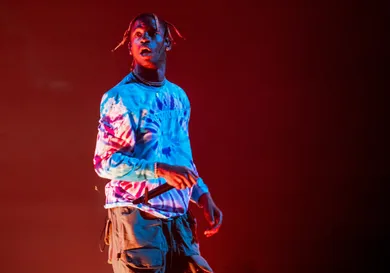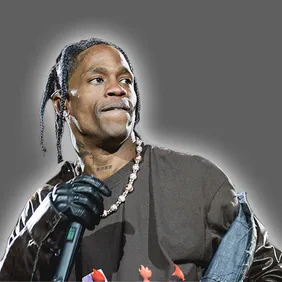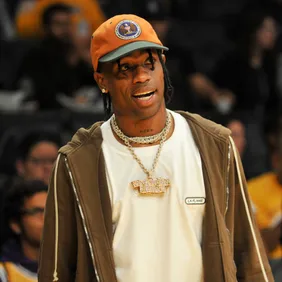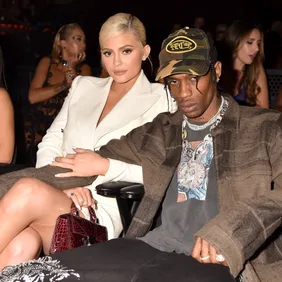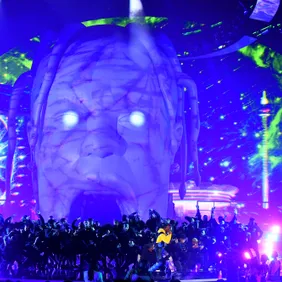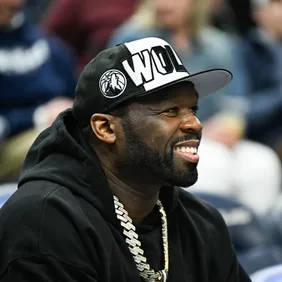Travis Scott opts to let his material do the talking, side-lining his personal life in favor of artistic evolution. Hinged around a stratospheric year-and-a-half, director White Trash Tyler takes us on an exhilarating ride with La Flame as he occupies popular culture’s driving seat without ever losing sight of himself. Within its opening moments, Travis maintains a composed demeanor as he’s hurtled around in a rollercoaster. Unflustered by its erratic movements, Travis holds a steady tone and speech pattern even as he’s launched high in the air. An excellent piece of cinematic storytelling in its own right, this sets the scene for a tale of a 20-something kid from Houston committed to overcoming any obstacle in the name of his inner child.
Grainy home video footage paints a young Jacques as something of a child prodigy, his father excitedly proclaiming him to “have that rhythm.” Akin to a far less disharmonious take on the paternal dynamic from Prince’s Purple Rain, there’s a sense of serendipity to Travis reaching the levels of worldwide notoriety that soul musician Jacques Webster Senior concedes to not having “the balls” to chase down. In fact, through the fleeting snippets that we get into the birth of his first child Stormi, it’s clear that fatherhood isn’t taken on frivolously and comes with the same duty of care that his father showed him. Stealing brief moments alone with his infant daughter, this theme of momentary calm before he’s engulfed by another whirlwind is felt when he’s seen eating lunch with Kylie, oblivious to all of the commotion brewing in anticipation of the pair hitting the street.
Kevin Winter/Getty Images
Affectionally dubbed as “Ragers,” witnessing the visceral response his fans have to his every utterance is a sight to behold. When the camera cuts to those in attendance at shows, testimonies such as “I don’t think I’ve ever felt so good in my life” and “he saved me” are commonplace. To the generation that was too young to witness Kanye or Cudi’s rise to prominence, the documentary paints Travis as a deified figure; this perception is only enhanced each time they grab his outstretched hand or when he saves them from ejection. When the gates open at Astroworld festival, the unbridled fanaticism is a throwback to the days where Elvis or The Beatles would enter to an outpouring of love that reached borderline-religious fervor.
When he speaks, it’s with purpose and authoritativeness, not out of a lack of manners but for an all-consuming desire to have his vision exacted. Case in point, the meticulous approach that is taken to his Saturday Night Live performance which is, by proxy, the first visualization of Astroworld beyond its surrealist album cover. After it goes off without a hitch, Travis's reactopm is best described by the input of one John Mayer: “you were singing from pure excitement. You made those notes ‘cos you were happy. I love when people get that melodic when they’re happy.”
A defogged window into his creative process, the thrill of being a fly-on-the-wall during the conception of the groundbreaking Astroworld refuses to dissipate throughout. Operating with an enviable foresight, it’s as if Travis has already seen the effect that his album would have on the hip-hop landscape as he lays down “No Bystanders." “This’ll change n****s drums, bpm’s, melodies, it’s gonna change his flows," he boldly states. "That’s what I’m trying to do. I could wait another year, and never hear another song like this. People are gonna go crazy on this one.” Minutes from hearing Travis speculate on the response that this Juice WRLD-assisted track will elicit, we see it brought to fruition as planned.
Beyond that, we see his temper begin to fray when the preproduction for the tour isn’t as he’d foreseen. Visually perturbed, there is no hint of remorse in his proclamation that until he feels happy with it, “nobody leaves.” To reach his footing in the industry, perfectionism is a must and Look Mom I Can Fly proves this to be an attribute that he has in abundance. However, things aren’t anymore eternally rosy in Travis’ disorienting world than they are in our own lives. Exposited through news reports and soundbites, Scott’s controversial Superbowl performance isn’t glossed over but rather contextualized through Akon’s TMZ interview on the matter. “As a people, we compromise in certain situations to get to better places," the Konvict remarked. "Why wouldn’t a black artist want to perform on one of the biggest events in the world? That don’t help us."
Randy Shropshire/Getty Images
It’s not the only time that Cactus Jack allows his vulnerability and insecurities to seep through. Beginning in a hotel suite as the nominations are announced, the documentary initially infers that Travis has no real use for perfunctory markers of status such as The Grammys. Sharply brought in focus by the contrast between his manager’s reaction to their three nominations and that of the artist himself, it seems as though Travis places less of an onus on critical praise and is contented with the approval of thousands of transfixed kids at his shows. However, the onset of the ceremony proves that his initial indifference was a protective smokescreen that veiled his true desire. Accustomed to seeing nominees politely applaud when they get passed over, watching La Flame pour every modicum of his heart and soul into Astroworld only to lose really brings home the adverse effect that rejection can have on an artist’s psyche. “After Sunday, I’ve been like mentally stressed,” he tells Houston Mayor Sylvester Turner. “I’ve been down, I lost man.” Realigned by words of wisdom from the elected official, the conclusion sees Travis get his clarity back and realize that the profound impact that he’s already left on the world and the city of Houston means more than certifications or mounted gold statues.
As much as it focuses on his present-day stature, the documentary uses touchstones of his past to depict how far he’s come. At one stage, a pre-teen Jacques is seen rapping at an amusement park, proclaiming “we on this merry go round, hold up we going to town.” Incidental as it may have seemed at the time, it serves to enhance the sense of it all coming full circle when Travis looks out upon his adoring Houstonians at his very own vision of Astroworld. Stood stageside with Stormi in his grasp, the footage is intercut with a glimpse at young Jacques and his mom, eagerly awaiting the chance for a day of escapism at the since-demolished original park. Later, at Stormi’s first birthday party, this emotive visual tool is deployed once more to show footage from his younger years, riding around in a baby-sized truck as Stormi had moments ago. Aside from peering into his childhood, flashbacks to sparsely attended shows in 2014 beautifully articulate his journey thus far.
Whether it’s lavish centrepieces such as his carnivalesque Madison Square Garden show or the sight of fans swarming his car to tell him what he means to them, even the most belligerent detractor of Travis Scott would be hard pushed to watch Look Mom I Can Fly and not come away feeling like he’s one of the most vital artists in the world today. An uncompromising look at the determination that it takes to make it, the documentary will stand as the definitive time capsule to one of the most exciting eras of La Flame’s career.
